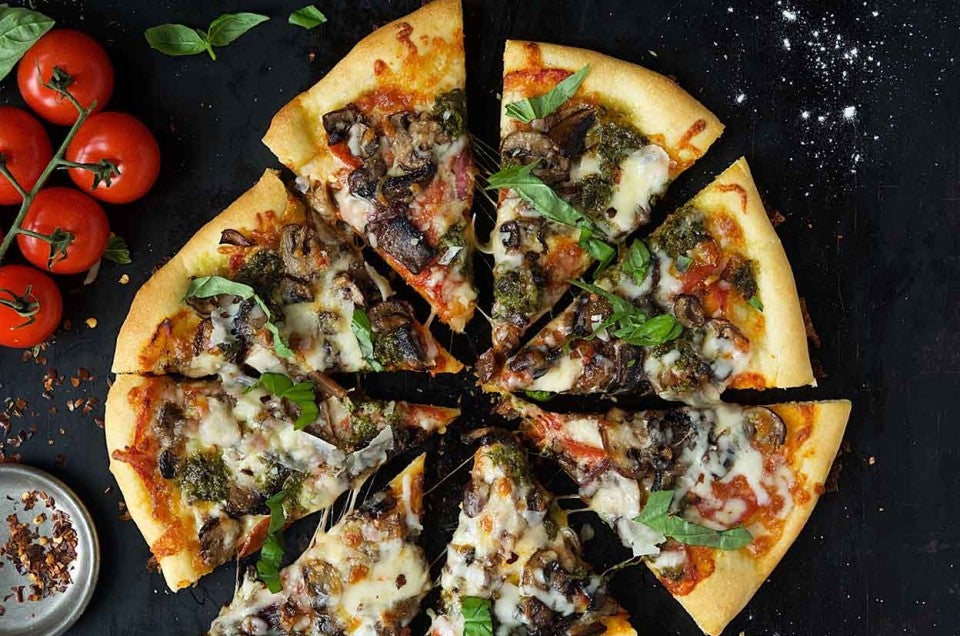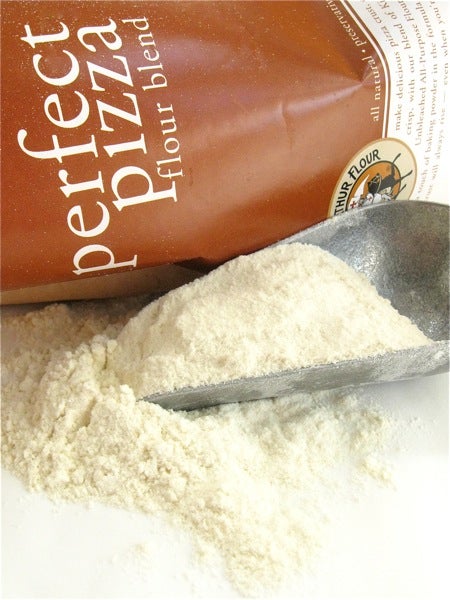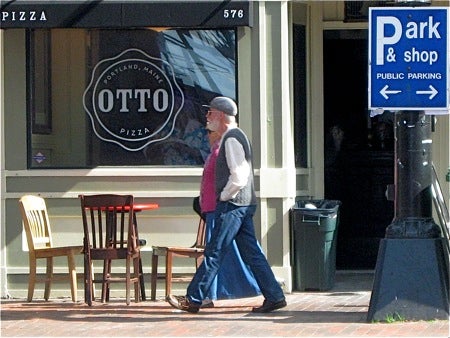


“In the spring a young man's fancy lightly turns to thoughts of love.” - Alfred, Lord Tennyson.
Well, Alfred, perhaps that was true 167 years ago, when you penned those words about England's young lads.
But it's not true as I write these words today, in White River Junction, Vermont, about my fellow King Arthur Flour Web team members.
In spring – and summer, winter, and fall, too – the Web team's fancy lightly turns to thoughts of...
Pizza.
Well, of course; we are, after all, a flour company. Anything made with yeast – read, pizza crust – relies heavily on flour. And since we're an employee-owned company, it's in our own best interest to be avid about pizza.
But the Web team's devotion to pizza goes way beyond avid. It's more like rabid. Scarcely a week goes by when I don't hear the plaintive request: “PJ, when are you going to be making pizza again?” I look up and see those hopeful faces... how can I resist? Into the kitchen I go.
And truthfully, it's no hardship. I've loved pizza since my mom started making the Appian Way version from a mix (flour, yeast packet, and can of tomato sauce in a cardboard box), back in the day. Mom is 85, and she's still making wonderful pizza – these days with the help of her bread machine, and a favorite crust recipe I gave her.
I've been making pizza myself for over 30 years. And strangely enough, I've never settled on a favorite recipe. I bounce from thick-and-doughy crust to thin-crackly-crunchy. I've baked pizza at 500°F on an oven stone, and 350°F in a pan. I've made pizza in a wood-fired cast iron cookstove (rescued from the bottom of a lake and restored); and in everything from a behemoth Garland gas oven to an electric toaster oven.
Not surprisingly, every pizza I've made has been thoroughly delightful. See, that's the thing about pizza; you just can't go wrong, no matter how hard you try. It's like chocolate: even bad chocolate is good chocolate.
This week my fellow Webbies started asking for pizza again. But they couldn't agree on a day; between meetings, family responsibilities, and days off, there was no time we could all be together – except for one small window on Thursday.
Ah-HA! Time for Now or Later Pizza, the busy person's solution to pressures of work. Make the crust and partially bake it when you have a chance. Then, set it aside till you're ready for pizza.
Just as your team – or family – is getting hungry and casting hopeful glances your way, add toppings, throw it in the oven, and bingo! Ten minutes later, hot, oozing-cheese, aromatic pizza.
Or to put a business operations spin on it, Just-in-time Pizza (a.k.a. Now or Later Pizza).

We often use semolina in pizza crust; it gives it a bit of chew, and a bit of color.
And what, exactly, is semolina? It's durum wheat (a high protein wheat) that's been ground to the consistency of cornmeal. In fact, semolina looks almost exactly like cornmeal. The difference is, semolina has protein to build gluten; cornmeal has no gluten-building protein. So you can blend semolina with all-purpose flour to make great yeast breads and pizza crusts.

Or take a shortcut – our Pizza Flour Blend combines King Arthur Unbleached All-Purpose Flour with golden durum (a finer grind of semolina), plus dough conditioner – no "fighting back" as you roll! A touch of baking powder in the blend gives your crust extra "pop" in the oven.

And here's my other must-have pizza crust ingredient: pizza dough flavor. A few teaspoons in your dough really does give it “pizza parlor POP.”
I'm making dough in my stand mixer here, though your bread machine is an equally good choice. So – put the following in your mixer bowl (or bread machine bucket):
1 3/4 cups (206g) King Arthur Unbleached All-Purpose Flour
1 1/4 cups (206g) semolina*
1 tablespoon + 1 teaspoon (8g) Pizza Dough Flavor (optional, but delicious)
1 teaspoon instant yeast
1 1/4 teaspoons salt
*Use 3 cups all-purpose flour OR 3 cups Pizza Flour Blend in place of the all-purpose/semolina mixture, if desired
Add 2 tablespoons olive oil, and 1 cup + 2 tablespoons to 1 1/4 cups (255 to 283g) lukewarm water.
Can you forego the semolina, and use all-purpose flour instead? Of course. You'll want to use 2 tablespoons less water if you make the dough using 100% all-purpose flour, instead of the combination of AP and semolina.
Mix for 2 minutes, using the flat beater paddle, to make a soft, sticky dough.
Scrape down the sides of the bowl...
...switch to the kneading hook, and knead for about 5 minutes.
Here's the dough made with all-purpose flour, no semolina; it'll be somewhat stickier, as you can see.
Put the dough in a lightly greased container of some sort. I like to use an 8-cup measure, so I can easily track the dough's progress. Let the dough rise for about 45 minutes at room temperature, then refrigerate for up to 36 hours.
WHOA! Here it is after 18 hours in the fridge. Nice rise... and wonderful flavor. As dough slowly rises in the fridge, the growing yeast releases organic acids and alcohol, which really enhance the dough's flavor.
Divide the dough in half. This simply makes it easier to handle. Want to make one giant 14” thick-crust pizza? Go for it! Don't divide the dough.
Working with one piece at a time, pick it up by the edge, and let gravity stretch it out. Work your fingers around the perimeter of the dough, turning it in your hands so it stretches itself into an irregular oval. When it starts thinning out too much, or becomes hard to handle, set it on a piece of parchment.
Continue pressing the dough till it's as flat as you like. I've made this piece of dough about 12” x 14”; this will make a thin-to-medium thickness crust.
A large peel is a big help in moving crust from counter to pizza stone, and stone to cooling rack.
I've shaped the other piece of dough into a 9” x 10” or so oval; this will make a thicker crust, obviously. And though it flops over the edges a tiny bit, I can use my handy giant spatula to move it around.
Cover the shaped crusts. Use greased plastic wrap, or an overturned clear plastic cover from a deli tray... whatever you can find to set over the dough and keep it from drying out. Start to preheat your oven to 450°F. If you have a pizza stone, put it on a lower rack.
After 30 minutes – longer, if you want a thicker crust – place the crust and its parchment onto the hot stone. See why I love parchment? No need to fool around with messy cornmeal (which inevitably burns on the bottom of the crust anyway). And parchment, unlike cornmeal, will never allow your dough to stick to the peel.
Check your dough after a couple of minutes. WHOOPS. Reach in with a cake tester or toothpick and pop any big bubbles.
Ah, that's better.
After 6 minutes (for the thinner crust) or 7 to 8 minutes (for the thicker crust), remove from the oven. The dough will feel set and dry, but still soft inside. It definitely won't be fully baked... more like half-baked. Bake your second crust the same way.
At this point, you can set the crusts aside to cool, then wrap and store till you're ready to top and make into pizza. Think those supermarket Boboli crusts... same deal.
So, say you're having pizza night on Tuesday, but want to make the crusts Sunday. No problem. Make them Sunday, and simply store in plastic, on the counter, until Tuesday. For longer storage (up to 5 days), refrigerate. You can even freeze these, well-wrapped, for up to 4 weeks.
OK, back to that warm crust you just pulled out of the oven. Top it with whatever you like. Since the topped pizza won't bake for every long, make sure any meat or veggies are already cooked. Here I'm using Italian sausage, goat cheese, and tomato sauce.
Bake for about 8 minutes – on an upper rack of the oven. I baked this one on the stone, and found it made the bottom too brown, and the top too pale.
Here's a neat trick: As soon as you pull your pizza out of the oven, scatter a handful of finely shredded cheese over the top.
The oven's heat will partially melt the cheese. It looks nice, and adds even more melted cheese – always a good thing!
This is one of my larger (12” x 14”) crusts, which I let rise for about 30 minutes before baking. Note the thick edge, thinner center.
And this is a smaller crust (9” x 10”), which I let rise for a full hour before baking. Note its extra-thick outer edge, and uniformly thick center.
Now, for some topping experiments. This is a simple Pizza Margherita: fresh tomatoes, mozzarella, and basil. I added the fresh basil leaves after the pizza had come out of the oven. The bright green leaves looked lovely against the white-and-red background.
Then I thought, well, maybe I should just run the pizza through the oven for 10 seconds, to ”meld” the basil to the cheese. BIG MISTAKE. Even that tiny bit of oven heat turned my lovely green leaves a mottled gray.
This is a tasty vegetarian topping: sautéed mushrooms, cheese, and sliced fresh (not cooked) garlic. Putting the mushrooms and garlic atop a bed of cheese, instead of sprinkling the cheese on top, makes for a prettier presentation.
And here's one for the traditionalists: thick-crust pepperoni and mozzarella.

And finally, for you NON-traditonalists – Food Network magazine named its top 50 pizzas (one for each state), and this was Maine's winner: buttery mashed Red Bliss potatoes, sprinkled with coarse black pepper, then topped with bacon and scallions...

...courtesy of Otto's, in Portland. Drop by if you're in the neighborhood.
Mashed potato pizza? You be the judge!
Read, rate, and review (please) our recipe for Now or Later Pizza.